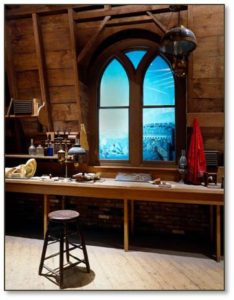People who read my Thursday posts about Boston, especially the series on Hidden Gems, have asked me online and in person how I got started and where I get ideas. So just in case you were wondering too, I decided to answer the question here.
How It Started
It started with Tenshin-en, the Japanese Garden behind the Boston Museum of Fine Arts because we had just been to an exhibit @MFA. Standing in the gift shop, I noticed how difficult it was to see down into the garden below and noticed people walking by on the Fenway with no idea what was inside those gates. So I wrote about it. Then I wondered about other places in Boston that were equally interesting but generally ignored because people don’t know they exist or what they mean.
A few came to mind immediately: the Mapparium, the Salada Tea Doors, the Ether Dome and some others. Then I thought about places I had heard about but never visited. Sometimes I wasn’t even sure where they were—or whether they existed at all. I tapped my fellow docents at Boston By Foot for ideas and they flooded in from people who know Boston’s history, architecture, and urban anomalies better than most history majors.
(Apologies to the many folks who suggested Cambridge locations. I want to stick to this side of the Charles River, at least for now. But I’d love to have guest posts from the Cambridge experts. Let me know if you’re interested in being published)
Building a List of Hidden Gems
Now that I had compiled a bigger list of potential Hidden Gems to work from, I started to do some sleuthing. I hunted down places I had walked past and wondered about or just heard about. I used books and the Internet to search for background information, dates, architects, styles and history. I called people to ask questions about all sorts of things, including availability. All the locations in the Hidden Gems series have to be accessible to the public. It can’t be a Hidden Gem if you have to make an appointment with someone in a position of authority just to gain access. This process took me down some obscure pathways, chasing clues to new Hidden Gems.
Because I live about 25 miles west of Boston, I combined these exploratory expeditions with my Boston By Foot tour schedule to get the most from each trip. Sometimes, though, I just drove into the city to walk around, poking into buildings, reading signs, getting ideas and taking pictures.
Disappointments
On a few occasions my searches have left me disappointed. Three examples:
-
I wanted to write about the undercroft at Trinity Church where the bookstore provided public access. In this space under the church you can view the four enormous granite pyramids that cover 500 wooden pilings each. These structures form the foundation for the church’s tower. The undercroft also includes granite pieces of the old church on Summer Street that burned in the Great Fire of 1872.
Walking confidently inside the west porch, I encountered a guard who told me the bookstore had been moved and the undercroft closed. What a disappointment! No access, no Hidden Gem.
-
Just last week I searched out the Boston Public Library’s dioramas, which I had seen mentioned in one of the articles I researched. It took conversations with two helpful people at information desks before I found the Wiggin Gallery, which houses the dioramas.
That’s where my search stopped because the gate across the door was closed and padlocked, the room dark. I could see where the dioramas were but I could not see what was inside those black rectangles in the wall. Why? Who knows? But I’ll bet the kids in the new Children’s Section would love to see them.
- The old New England Telephone headquarters at 6 Bowdoin Square used to house a reconstruction of Alexander Graham Bell’s laboratory. It was built from materials that had been salvaged from its original site on Court Street when the building was razed. During a renovation of the NET headquarters, however, the office disappeared and i haven’t been able to find out what happened to it.
Old Structures, New Buildings
As I wrote, the list of Hidden Gems grew longer, I began receiving suggestions from readers. Just this week I talked to a woman who is writing a book and wants to reference some of my posts. During our conversation she mentioned several places that I need to explore because they should make excellent topics.
With many places still unexplored on my growing list I can keep going for some time but I’m always happy to get suggestions and recommendations. Boston changes every day as old buildings come down and new buildings go up.
Sometimes that process uncovers an old gem. Sometimes pieces of old structures are incorporated into snazzy new glass constructs, as with the Exchange Staircase. That creates a new site that people walk by every day without knowing the history of what they’re passing or stopping to read a plaque that would educate them.
There’s always something new to see and learn. Writing about Boston’s Hidden Gems feels like a combination of collecting, researching, and going on a scavenger hunt. I’m happy to keep the process going as long as I can.
NOTE: You can find the complete list of Boston’s Hidden Gems, along with other series and posts, on the Posts About Boston page. The list includes a map along with directions and information on how to get there.
P.S.: I am always looking for suggestions about Hidden Gems in Boston that I can include in the series. If you have one, please post it in the Comments section.




